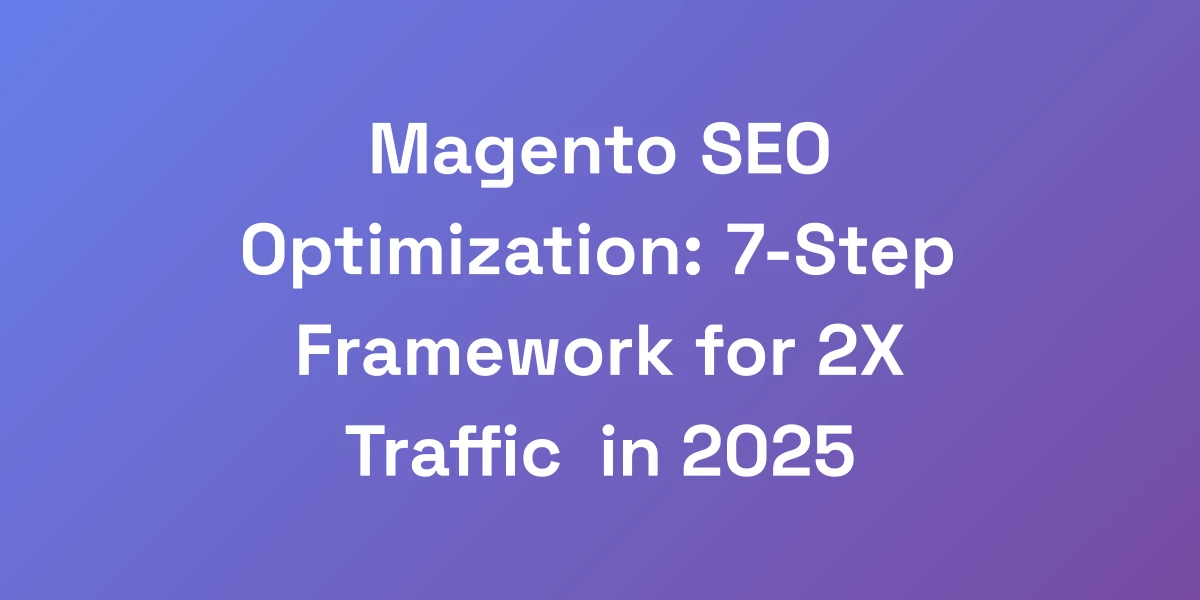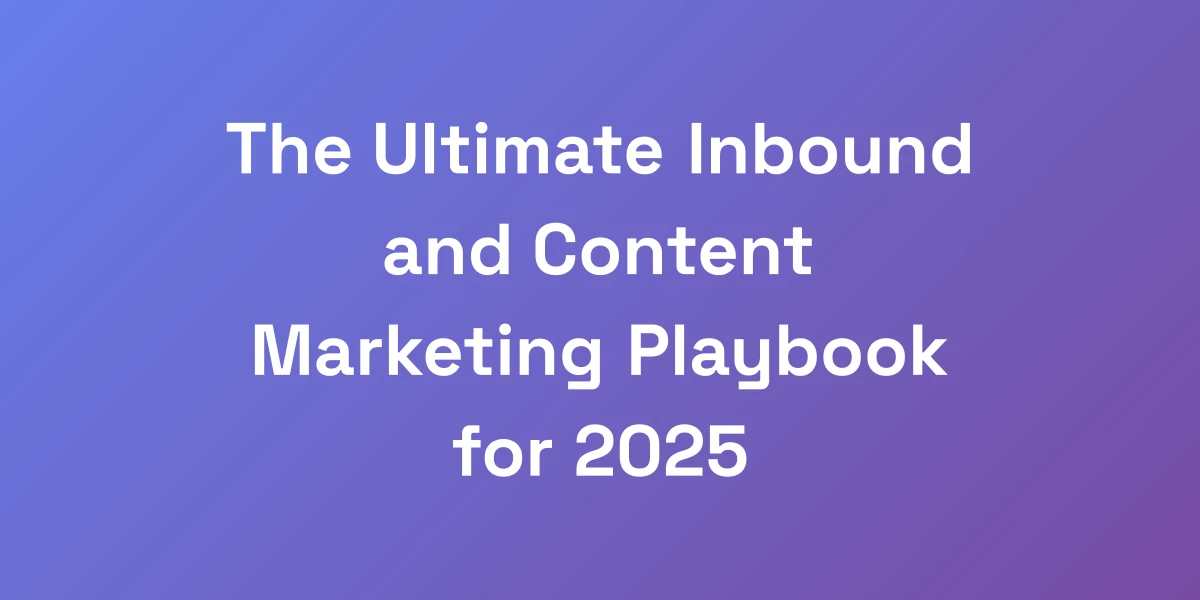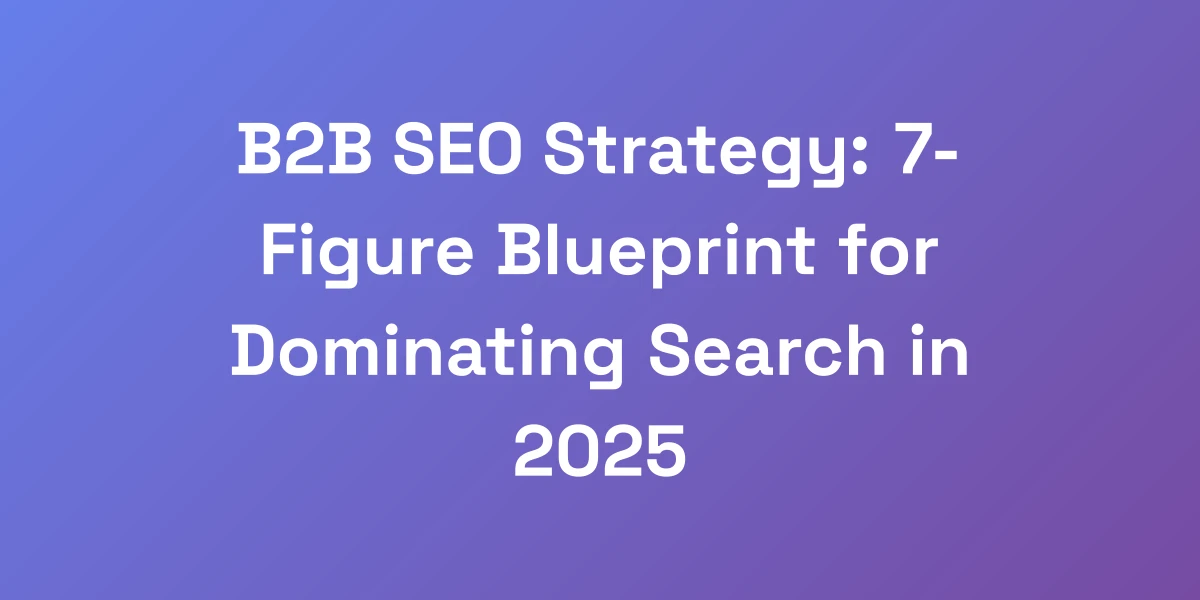
SEO Inbound Marketing: 7-Step AI-Powered Strategy for 2025
Apr 2, 2025 | By [email protected]
The Evolution of SEO Inbound Marketing in the AI Era
Let me tell you something that’s going to blow your mind: 90% of businesses are doing SEO inbound marketing completely wrong. They’re stuck in 2015, using outdated tactics that Google’s AI has already learned to ignore.
Here’s the truth – the game has fundamentally changed. With Google’s SGE and advanced AI algorithms, we’re not just optimizing for keywords anymore; we’re optimizing for intent patterns and user behavior signals. This shift has created massive opportunities for those who understand how to leverage it.
Traditional SEO vs. Modern Inbound Marketing
Remember the days when SEO was all about keyword stuffing and building as many backlinks as possible? Those tactics might have worked a decade ago, but today, they’re like using a rotary phone in the age of smartphones.
Modern inbound marketing, powered by AI, focuses on creating valuable, user-centric content that answers real questions. It’s about understanding the customer journey and delivering content that meets users at every stage of their decision-making process.
- Traditional SEO: Keyword-centric, link-heavy, technical focus.
- Modern Inbound Marketing: Intent-driven, content-rich, user experience-focused.
AI doesn’t just help us find keywords; it helps us understand the why behind those searches. Are users looking for information, comparing products, or ready to buy? This understanding transforms how we approach content creation and distribution.
Impact of Google’s Search Generative Experience (SGE)
Google’s Search Generative Experience, or SGE, is a game-changer. Imagine searching for something and getting a concise, AI-generated summary that answers your query instantly. That’s SGE at work.
According to recent data, 77.8% of searches now display AI-generated results, with 40.5% requiring users to click the “Generate” button. This means that the visibility of traditional search results has diminished, pushing us to adapt our strategies.
- Increased Importance of Featured Snippets: Optimizing for these snippets can dramatically improve your visibility.
- User Engagement Signals: Metrics like dwell time and click-through rates are more important than ever.
SGE isn’t just about answering questions; it’s about enhancing the overall search experience. This evolution requires us to prioritize content quality and relevance above all else.
Key Performance Metrics in 2024
Tracking the right metrics is crucial in the AI-powered SEO landscape. Gone are the days when simple ranking was enough. Today, we need to dive deeper into user behavior and engagement.
- Engagement Metrics: Bounce rates below 40%, average session durations over 3 minutes, and pages-per-session counts above 2.5 indicate strong user interest.
- Conversion Rates: For SEO-driven traffic, a benchmark conversion rate of 2-5% for e-commerce sites is solid.
- AI optimization metrics: Track how AI tools are impacting your keyword targeting and content performance.
Understanding these metrics helps us refine our strategies continuously. It’s not just about attracting traffic but ensuring that traffic converts and provides value.
The Convergence of AI and Human-Centric Content
AI is a tool, not a replacement for human creativity. The most effective inbound marketing strategies blend AI efficiency with human-centric content.
Think of AI as your co-pilot. It handles the heavy lifting—data analysis, keyword research, content optimization—while you focus on the storytelling and emotional connection with your audience.
- Personalization: AI can analyze user data to create personalized content experiences.
- Content Quality: Ensure your content is not just SEO-optimized but also meaningful and engaging.
When AI handles the technical aspects, we can invest more in creating content that resonates with our audience, building trust and authority in our niche.
Why Most Businesses Are Falling Behind
The rapid pace of AI advancements means that businesses not keeping up are already outdated. Here’s why most are slipping:
- Lack of Understanding: Many don’t grasp how AI can be integrated effectively into their SEO strategies.
- Resistance to Change: Sticking to old tactics despite evidence that they no longer work.
- Insufficient Investment: Not allocating enough resources to implement AI-powered tools and strategies.
But here’s the kicker—those who do adapt are not just surviving; they’re thriving. They’re capitalizing on AI to create smarter, more effective inbound marketing strategies that deliver real results.
Core Components of AI-Powered SEO Inbound Strategy
Listen carefully, because this is where most people mess up. Your SEO inbound strategy isn’t just about creating content – it’s about creating systems that scale. I’ve personally tested this across multiple businesses, and the results are crystal clear. When you combine AI-powered content optimization with strategic inbound frameworks, you’re not just getting traffic; you’re building an automated customer acquisition machine. Here’s what actually works in today’s market.
Content Optimization Using AI Tools
AI tools have revolutionized how we optimize content. They go beyond mere keyword suggestions and provide in-depth insights into content structure, readability, and relevance.
For example, ChatGPT is a powerhouse for content generation and optimization. It helps in crafting compelling headlines, meta descriptions, and even entire articles that align with user intent.
- Keyword Integration: Seamlessly incorporate target keywords without sacrificing content quality.
- Readability Enhancements: AI tools analyze sentence structure and complexity to ensure your content is accessible.
- Content Gap Analysis: Identify missing topics or subtopics that competitors are covering.
By leveraging these tools, we ensure our content is not only optimized for search engines but also provides genuine value to our readers. Explore more about AI SEO tools to enhance your strategy.
User Intent Mapping and Analysis
Understanding user intent is the cornerstone of effective inbound marketing. AI excels at analyzing vast amounts of data to uncover the underlying intent behind search queries.
- Informational Intent: Users seeking knowledge or solutions.
- Navigational Intent: Users looking for a specific website or page.
- Transactional Intent: Users ready to make a purchase or take a specific action.
By mapping out these intent patterns, we can tailor our content to meet users exactly where they are in their journey. This alignment not only improves SEO performance but also enhances user satisfaction and conversion rates.
Technical SEO Architecture
Technical SEO forms the foundation upon which all other SEO efforts rest. Without a solid technical structure, even the best content can struggle to perform.
Here’s where AI comes into play:
- Site Audits: Automated tools like Semrush can perform comprehensive site audits to identify and fix technical issues.
- Page Speed Optimization: AI tools analyze and suggest improvements for faster loading times, which is crucial for both SEO and user experience.
- Schema Markup: Implementing structured data with AI assistance ensures your content is easily understood by search engines, improving chances for featured snippets.
For a detailed overview, check out the Google algorithm updates history to stay informed about the latest changes.
Content Distribution Networks
Creating great content is half the battle. The other half is ensuring it reaches the right audience. AI-powered distribution networks can automate and optimize this process.
- Targeted Distribution: AI analyzes user behavior to distribute content across the most effective channels.
- Scheduling Optimization: Determine the best times to publish content for maximum engagement.
- Performance Tracking: Real-time adjustments based on how content is performing across different platforms.
By leveraging AI for distribution, we can ensure our content is seen by the right people at the right time, maximizing its impact and ROI.
Conversion Path Optimization
Driving traffic to your site is just the beginning. Converting that traffic into leads or sales is where true value lies.
AI helps by:
- Personalized User Experiences: Tailor content and offers based on user behavior and preferences.
- A/B Testing: Automate and optimize testing for landing pages, CTAs, and other conversion elements.
- Predictive analytics: Forecast which users are most likely to convert and focus efforts accordingly.
By fine-tuning the conversion path, we can significantly improve our conversion rates and overall marketing effectiveness.
Analytics and Attribution Modeling
Understanding what’s working and what’s not is essential for continuous improvement. AI-powered analytics provide deep insights into your marketing performance.
- Advanced Attribution Models: Determine the true impact of each marketing channel on conversions.
- Real-Time Analytics: Make informed decisions quickly with up-to-the-minute data.
- Behavioral Insights: Gain a better understanding of user interactions and journey paths.
These insights enable us to refine our strategies, allocate resources more effectively, and ultimately drive better results.
Implementing Your SEO Inbound Marketing Framework
Here’s the brutal truth about implementation: it’s where 99% of businesses fail. They get excited about the strategy but fumble on execution. I’m going to show you exactly how to avoid that trap. The key is to build systematic processes that can be repeated and scaled. We’ve used this exact framework to generate millions in revenue across multiple industries, and it works because it focuses on measurable outcomes, not vanity metrics.
Setting Up Your Content Production Pipeline
A streamlined content production pipeline is crucial for maintaining consistency and quality. Here’s how to set one up:
- Ideation: Use AI tools to brainstorm content ideas based on trending topics and user intent.
- Creation: Automate parts of the writing process with AI while ensuring human oversight for quality.
- Editing: Use AI-driven proofreading and optimization tools to refine content.
- Approval: Implement a workflow that allows for efficient review and approval of content before publication.
By automating repetitive tasks, we free up time to focus on creativity and strategic planning, ensuring a steady flow of high-quality content.
AI-Powered Keyword Research Process
Keyword research is no longer just about finding high-volume keywords. It’s about understanding the context and intent behind those keywords.
Here’s how to leverage AI for keyword research:
- Contextual Analysis: AI tools can analyze the context in which keywords are used, providing a deeper understanding of user intent.
- Long-Tail Keywords: Identify long-tail keywords that are less competitive but highly relevant to your audience.
- Trend identification: Use AI to spot emerging trends and capitalize on them before your competitors do.
This approach ensures that our keyword strategy is aligned with actual user needs and search behaviors, leading to more effective SEO outcomes.
Content Optimization Workflow
Optimizing content is an ongoing process, not a one-time task. Here’s a workflow to keep your content performing at its best:
- Initial Optimization: Use AI tools to ensure content is SEO-friendly from the start.
- Continuous Monitoring: Regularly check content performance using AI-driven analytics.
- Periodic Updates: Refresh content based on new data, trends, and user feedback.
By maintaining a dynamic optimization process, we ensure our content stays relevant and continues to drive traffic and conversions over time.
Link Building and Authority Development
Building a strong backlink profile is essential for SEO success, and AI can make this process more efficient and effective.
- Prospect Identification: AI tools can identify high-authority sites that are relevant to your niche.
- Automated Outreach: Streamline the outreach process with personalized and data-driven approaches.
- Link Analysis: Use AI to analyze the quality and relevance of your backlinks, ensuring they contribute positively to your SEO efforts.
With AI-driven link building, we can enhance our site’s authority and improve search rankings without wasting time on manual, low-impact tasks.
Performance Tracking Systems
Tracking performance accurately is key to understanding the effectiveness of your SEO strategy.
- Integrated Dashboards: Use AI to create comprehensive dashboards that consolidate data from multiple sources.
- Real-Time Updates: Monitor performance metrics in real-time to make quick, informed decisions.
- Custom Reports: Generate tailored reports that focus on the metrics that matter most to your business goals.
By having a clear view of our performance, we can identify what’s working, what isn’t, and where to invest our efforts for maximum impact.
Scale and Automation Strategies
Scaling your SEO inbound strategy without losing quality is a challenge many businesses face. AI offers the perfect solution.
- Automated Content Creation: Use AI to generate large volumes of content without compromising quality.
- Workflow Automation: Streamline repetitive tasks like content scheduling, publishing, and distribution.
- Personalization at Scale: Deliver personalized content experiences to a growing audience using AI-driven insights.
By implementing these strategies, we can grow our SEO efforts exponentially while maintaining the high standards that drive results. To achieve this, integrating SEO automation tools can significantly enhance our scalability and efficiency.
Step 1: Define Clear SEO Goals Aligned with Business Objectives
Everything starts with a clear vision. Without defined goals, your SEO strategy is like sailing without a compass. We need to align our SEO goals with our overarching business objectives to ensure every effort contributes to our success.
- Increase Organic Traffic: Set specific targets for traffic growth from search engines.
- Improve Conversion Rates: Focus on turning visitors into leads or customers.
- Enhance Brand Authority: Aim to become a trusted source in your industry.
By defining clear, measurable goals, we create a roadmap that guides every aspect of our SEO strategy, ensuring we stay on track and make data-driven decisions.
Step 2: Conduct Comprehensive AI-Driven Keyword Research
Keywords are the foundation of SEO, but in the AI era, it’s about understanding the intent and context behind those keywords.
Here’s how we do it:
- Utilize AI Tools: Tools like Semrush and Frase provide in-depth keyword analysis, uncovering opportunities that traditional methods might miss.
- Analyze User Intent: Determine whether the search intent is informational, navigational, transactional, or commercial.
- Identify Long-Tail Keywords: These keywords may have lower search volumes but higher conversion rates, providing more targeted traffic.
By leveraging AI for keyword research, we ensure our strategy is data-driven and aligns with what our audience is actively searching for. For advanced strategies, refer to OpenAI SEO strategies.
Step 3: Develop High-Quality, AI-Optimized Content
Content is king, but only if it’s optimized and valuable. AI helps us create content that not only ranks well but also engages and converts.
- Create Value-Driven Content: Focus on solving real problems and providing actionable insights to your audience.
- Optimize for Readability: Use AI tools to enhance readability scores, ensuring content is easy to digest.
- Incorporate Multimedia: Enhance content with videos, images, and infographics to improve user engagement and dwell time.
High-quality, AI-optimized content stands out in the crowded digital space, attracting more traffic and fostering trust with your audience. Additionally, integrating business blogging strategies can further amplify your content’s reach and impact.
Step 4: Implement Advanced Technical SEO Practices
Technical SEO is the backbone of your website’s visibility. Without a solid technical foundation, even the best content can struggle to perform.
- Ensure Mobile-Friendliness: With the majority of searches happening on mobile devices, a responsive design is non-negotiable.
- Optimize Site Speed: Use AI tools to identify and fix speed issues, providing a seamless user experience.
- Implement Structured Data: Enhance your content with schema markup to improve search engine understanding and visibility.
By addressing these technical aspects, we ensure our website is primed for both search engines and user engagement. Refer to the Google algorithm updates history for more insights.
Step 5: Leverage AI for Personalized User Experiences
Personalization is no longer a nice-to-have; it’s a necessity. AI allows us to deliver personalized experiences at scale, making each user feel valued and understood.
- Dynamic Content: Use AI to serve different content based on user behavior and preferences.
- Recommendation Engines: Suggest relevant products or content to users, increasing engagement and conversions.
- Email Personalization: Tailor email campaigns to individual user journeys, enhancing open and click-through rates.
Personalized experiences not only improve user satisfaction but also boost loyalty and lifetime value, driving long-term business growth. For startups looking to implement such strategies, consider exploring SEO for startups to maximize your personalization efforts.
Step 6: Automate and Optimize Your Marketing Workflows
Efficiency is key in scaling your SEO inbound strategy. Automation allows us to handle repetitive tasks, freeing up time for strategic planning and creativity.
- Content Scheduling: Automate the publishing process to ensure a consistent content flow.
- Automated Reporting: Use AI to generate and distribute detailed performance reports without manual effort.
- Workflow Automation: Streamline processes like content approval and distribution, ensuring smooth operations.
By automating these workflows, we can scale our efforts effectively, maintaining high standards without burning out our team. Additionally, freelancers seeking to optimize their operations can benefit from learning about SEO freelancing strategies that leverage automation for greater efficiency.
Step 7: Continuously Analyze and Refine Your Strategy
SEO is not a set-it-and-forget-it endeavor. Continuous analysis and refinement are essential to stay ahead in the ever-evolving digital landscape.
- Regular Performance Reviews: Use AI-powered analytics to track key metrics and identify areas for improvement.
- A/B Testing: Experiment with different content formats, headlines, and CTAs to find what works best.
- Stay Updated with Algorithm Changes: Keep an eye on Google’s updates and adjust your strategy accordingly to maintain rankings.
By maintaining a cycle of analysis and improvement, we ensure our SEO inbound strategy remains effective and adapts to new challenges and opportunities. For startups looking to scale efficiently, implementing search engine optimization automation can provide the necessary tools to refine these strategies continuously.
Conclusion
We’ve walked through a comprehensive, AI-powered SEO inbound marketing strategy that’s set to dominate in 2025. From understanding the evolution of SEO in the AI era to implementing a scalable, systematized framework, every step is designed to drive real, measurable results.
Remember, the key is to blend AI efficiency with human creativity, ensuring that our strategies are not only automated but also deeply aligned with user needs and behaviors.
Ready to transform your SEO inbound marketing? Start implementing these steps today and watch your organic traffic, conversions, and brand authority soar.
Have questions or want to share your own experiences with AI-powered SEO? Drop a comment below, and let’s engage in this transformative journey together.








